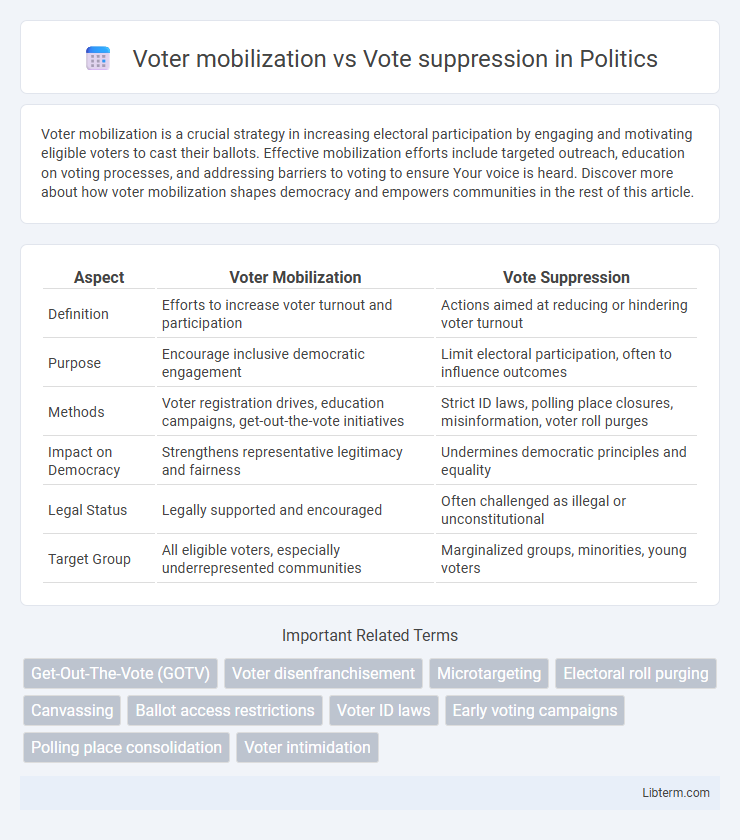Voter mobilization is a crucial strategy in increasing electoral participation by engaging and motivating eligible voters to cast their ballots. Effective mobilization efforts include targeted outreach, education on voting processes, and addressing barriers to voting to ensure Your voice is heard. Discover more about how voter mobilization shapes democracy and empowers communities in the rest of this article.
Table of Comparison
| Aspect | Voter Mobilization | Vote Suppression |
|---|---|---|
| Definition | Efforts to increase voter turnout and participation | Actions aimed at reducing or hindering voter turnout |
| Purpose | Encourage inclusive democratic engagement | Limit electoral participation, often to influence outcomes |
| Methods | Voter registration drives, education campaigns, get-out-the-vote initiatives | Strict ID laws, polling place closures, misinformation, voter roll purges |
| Impact on Democracy | Strengthens representative legitimacy and fairness | Undermines democratic principles and equality |
| Legal Status | Legally supported and encouraged | Often challenged as illegal or unconstitutional |
| Target Group | All eligible voters, especially underrepresented communities | Marginalized groups, minorities, young voters |
Understanding Voter Mobilization and Vote Suppression
Voter mobilization entails strategies such as voter registration drives, get-out-the-vote campaigns, and education efforts that aim to increase electoral participation, especially among underrepresented groups. Vote suppression includes tactics like strict voter ID laws, purging voter rolls, limiting early voting, and misinformation campaigns designed to reduce voter turnout. Understanding these contrasting approaches is crucial for analyzing their impacts on democratic participation and electoral fairness.
Historical Context of Voter Mobilization Efforts
Historical voter mobilization efforts in the United States date back to the late 19th century with movements such as the Populist Party advocating for expanded suffrage and electoral reforms. The Civil Rights Movement of the 1960s marked a pivotal era, highlighted by the Voting Rights Act of 1965, which aimed to eliminate racial discrimination in voting and significantly increased voter registration among African Americans. Ongoing mobilization initiatives have since targeted marginalized communities to enhance political participation and counteract systemic barriers erected through tactics of vote suppression.
Tactics and Strategies in Vote Suppression
Vote suppression tactics strategically restrict voter access through measures such as stringent voter ID laws, purging voter rolls, limiting early voting, and closing polling stations in marginalized communities. These strategies often involve misinformation campaigns, stringent registration requirements, and aggressive poll monitoring to intimidate and discourage voters. Targeted efforts focus on disenfranchising specific demographic groups, including minorities, the elderly, and young voters, undermining equitable participation in elections.
Impact of Voter Mobilization on Election Outcomes
Voter mobilization significantly influences election outcomes by increasing turnout among key demographic groups, often leading to shifts in vote margins and overall results. Targeted campaigns that address specific communities' concerns enhance political engagement and can alter electoral dynamics in closely contested districts. Higher participation driven by effective mobilization strategies promotes more representative governance and strengthens democratic legitimacy.
Legal Frameworks Governing Voting Rights
Legal frameworks governing voting rights are crucial in distinguishing voter mobilization from vote suppression, as they establish protections against discriminatory practices and ensure equal access to the ballot. Laws such as the Voting Rights Act of 1965 prohibit tactics that intentionally disenfranchise minority voters, while provisions like early voting and mail-in ballots promote voter participation. Enforcement of these regulations by federal and state agencies is essential to uphold democratic principles and prevent the erosion of electoral fairness.
Demographic Groups Targeted by Mobilization and Suppression
Voter mobilization efforts often concentrate on increasing turnout among underrepresented demographic groups such as young voters, racial minorities, and low-income communities to strengthen their political influence. In contrast, vote suppression tactics frequently target these same groups through measures like strict voter ID laws, purging voter rolls, and limiting early voting access, disproportionately affecting Black, Latino, and Indigenous populations. Understanding the demographic focus of both mobilization and suppression highlights the ongoing struggle for equitable voter participation in U.S. elections.
The Role of Technology in Voter Engagement
Technology plays a pivotal role in voter mobilization by enabling targeted digital campaigns, real-time communication, and easy access to voter information, thus increasing voter turnout and engagement. Conversely, vote suppression tactics exploit technology through misinformation, cyber-attacks on election infrastructure, and restrictive digital access, which hinder voter participation. Leveraging data analytics and mobile platforms optimizes voter outreach while safeguarding cybersecurity is crucial to counteract technological barriers in the electoral process.
Case Studies: Successes and Failures in Mobilization vs Suppression
Case studies in voter mobilization reveal significant successes in increasing turnout, such as the 2008 U.S. presidential election where grassroots campaigns employed targeted outreach and digital tools to engage historically underrepresented groups. Conversely, instances of vote suppression, like the 2013 Shelby County v. Holder decision, resulted in the rollback of key voting protections, leading to decreased participation in marginalized communities due to strict ID laws and polling place closures. Comparative analyses highlight that while mobilization efforts can overcome barriers through education and legal advocacy, systemic suppression tactics often undermine these gains by exploiting legal loopholes and administrative hurdles.
Mitigating Vote Suppression: Policy and Advocacy
Mitigating vote suppression requires targeted policy reforms such as expanding early voting, implementing automatic voter registration, and enforcing strict penalties for discriminatory practices. Advocacy efforts focus on raising public awareness, supporting legal challenges against restrictive laws, and mobilizing community organizations to safeguard voter rights. Successful strategies combine data-driven approaches with grassroots engagement to ensure equitable access to the ballot.
Future Trends in Voter Mobilization and Suppression Tactics
Future trends in voter mobilization emphasize digital outreach, personalized data analytics, and mobile-friendly platforms to engage younger and diverse demographics effectively. Conversely, vote suppression tactics are evolving with sophisticated misinformation campaigns, stringent voter ID laws, and targeted purging of voter rolls, disproportionately affecting minority and marginalized communities. Emerging technologies and legal battles will shape the landscape, with ongoing efforts to balance accessibility and security in electoral processes.
Voter mobilization Infographic

 libterm.com
libterm.com